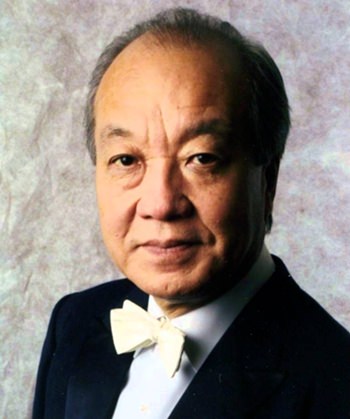With Christmas just around the corner, it occurred to me that I might tell you about some classical Christmas music. But then I thought “No. Why should I?” To be perfectly honest, I find the Christmas thing a bit of a bore and I’m jolly glad when the whole tiresome business is over. So instead, I’ll tell you about two interesting Japanese works that I discovered recently. And incidentally, it’s a fortunate coincidence that 23rd December just happens to be the birthday of the Japanese emperor.

Since the latter half of the nineteenth century, Japanese composers have tended to look towards Western musical culture as well as drawing on elements from Japanese traditional music. Kômei Abe was one of the leading Japanese composers of the twentieth century and his First Symphony of 1957 is a good introduction to Japanese classical-music-in-the-Western-style, although it’s a curious mix of musical idioms.
The prolific Toshiro Mayuzumi composed more than a hundred film scores and if you’d like an entertaining musical experience, seek out his Concertino for Xylophone and Orchestra which I believe is still available on YouTube. Kunihico Hashimoto was another leading Japanese composer whose music reflects elements of late romanticism and impressionism, as well as of the traditional music of Japan.
Oh yes, and I mustn’t forget Toru Takemitsu, perhaps the most revered of the whole lot. He composed hundreds of works that combined elements of Eastern and Western philosophy to create his own unique sound landscape. More than anyone, Takemitsu put Japanese music on the map.
Yûzô Toyama is a native of Tokyo who studied with Kan-ichi Shimofusa, a pupil of the German composer Paul Hindemith. The Rhapsody for Orchestra is probably the composer’s best-known work. He is also known as a conductor and for years held the post of chief conductor with the NHK Symphony Orchestra. In case you are wondering, NHK stands for Nippon Hôsô Kyôkai – the Japan Broadcasting Corporation. In 1960 Toyama conducted the orchestra on a world tour which included several of his most popular works.
As a composer, his most important musical influences were probably Béla Bartók and Dmitri Shostakovich. He is fond of incorporating Japanese traditional music into his work, drawing on folksongs and the classical Japanese dance-dramas of Kabuki theatre. Toyama has written well over two hundred compositions and has received numerous awards in Japan for his contributions to the nation’s musical life.
The Rhapsody for Orchestra dates from 1960 and is based on Japanese folk songs in which traditional instruments, including the kyoshigi (paired percussive wooden sticks) are blended into a conventional Western orchestra. You’ll notice distinctive Mikado-like moments from time to time. The work starts with thunderous percussion so keep your fingers on the volume control.
This is a splendid performance and the Polish musicians seem to enjoy playing the work. With excellent sound and video, it looks superb in full screen mode provided that your download speed and processor are fast enough.
Yoshimatsu is also from Tokyo and like his compatriot Toru Takemitsu, didn’t receive formal musical training until adulthood. He left the faculty of technology of Keio University in 1972 and became interested in jazz and progressive rock music, particularly through electronic means.
Yoshimatsu first dabbled in serial music but eventually became disenchanted with it and instead began to compose in a free neo-romantic style with strong influences from jazz, rock and Japanese traditional music. He’s already completed six symphonies, twelve concertos, a number of sonatas and shorter pieces for various ensembles. In contrast to his earlier compositions, much of his more recent work uses relatively simple harmonic structures.
This curiously-named work is technically a triple concerto and the ornithological reference reappears in his Symphony No. 6 written in 2014, subtitled Birds and Angels. Yoshimatsu described this concerto as alluding to “an imaginary bird in the realm of electronic cyberspace.” It’s a concerto for saxophone in all but name and uses a free atonal jazz idiom for the soloists against a conventional symphony orchestra. It was composed in 1993 for Hiromi Hara who performs it on this video. The three movements are entitled Bird in Colours, Bird in Grief, and Bird in the Wind.
There’s some brilliant playing from these talented young musicians with a lovely haunting second movement and a joyous third movement with some fine brass writing and a thunderous ending.
If you are into eclectic modern jazz this video, with its superb sound and video, will be right up your soi. As Mr Spock in Star Trek might have said to Captain Kirk, “It’s classical music Jim, but not as we know it.”
 |
 |
 |





